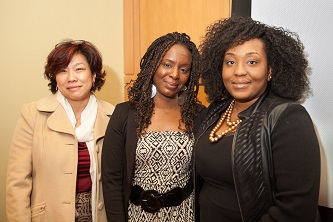Stacey Muhammad Speaks on Trailblazing Women Filmmakers of Color
March 21, 2014

Stacey Muhammad (center) is greeted by the Women's and Gender Studies Program's Endowed Postdoctoral Fellow Zinga A. Fraser (right) and Sau-Fong Au, director of the Women's Center.
Filmmaker and activist Stacey Muhammad spoke to a full house in the Brooklyn College Library's Woody Tanger Auditorium on March 18 as part of "Taking Risks and Blazing Trails: the History of Black Women Filmmakers and Redefining Representations in Film and Media," an event held in celebration of Women's History Month. Muhammad led the discussion by highlighting the history of pushing back against stereotypes and crafting more multidimensional portrayals of people of color, as well as the revolutionary role black women filmmakers have played in shaping the dissent.
The event was hosted by the Women's and Gender Studies Program in collaboration with the Department of Africana Studies, the Shirley Chisholm Project on Brooklyn Women's Activism, and the Women's Center.
"There is a legacy of rebellion in black film," Muhammad said. "There has always been an uprising of sorts on the part of black filmmakers who challenge the inadequacies, inaccuracies, and misrepresentations of Hollywood. And many of the filmmakers who took those risks have been black women."
Muhammad—creator of I Am Sean Bell, Black Boys Speak (2009), winner of the HBO/Media That Matters "Speak Out" Award; the acclaimed documentary Out of Their Right Minds: Trauma, Depression, and the Black Woman (2010); and the hit YouTube series For Colored Boys: Redemption, produced by actor Isaiah Washington (Grey's Anatomy) and political commentator Marc Lamont Hill—introduced guests to a number of black women filmmakers and their works.
Among them were Tressie Souders, who in 1922 wrote, directed, and produced A Woman's Error, believed to be the first film work created by a black woman; Zora Neale Hurston who made innovative, but little-known ethnographic films in the late 1930s/early 1940s; and Ava DuVernay, who in 2012 was the first black woman to win the Best Director Prize at the Sundance Film Festival. Muhammad explained that what linked these women and others was their commitment to countering the racist and sexist narratives of mainstream films. She said that this continued activism has invaluable real-world, social justice implications.
"The overrepresentation of black men and women in the prison industrial complex can be directly linked to shifts we see in representations of those groups in mainstream media," she said. "The danger lies in the fact that when a people are depicted in a negative way, it becomes acceptable to treat them in a negative way."
When a student in the audience asked Muhammad about how to combat these depictions, she answered that the issue is "really about lack of balance" and suggested that black artists in general begin to think about the impact of their work in that context.
"The shift [of the images of people of color in mainstream media] happened for the sole purpose of preventing us from being able to quickly and readily access the information we need. You really have to dig—and more than dig, want—to find out what this is all about. That's crucial in understanding the problematic ways in which we interact with other human beings for love, affection, and attention. We have to be honest about how this affects all of us. It's necessary to remain critical and make sure safe spaces are created for artists who are systematically oppressed to tell fuller, richer stories about our lives."






